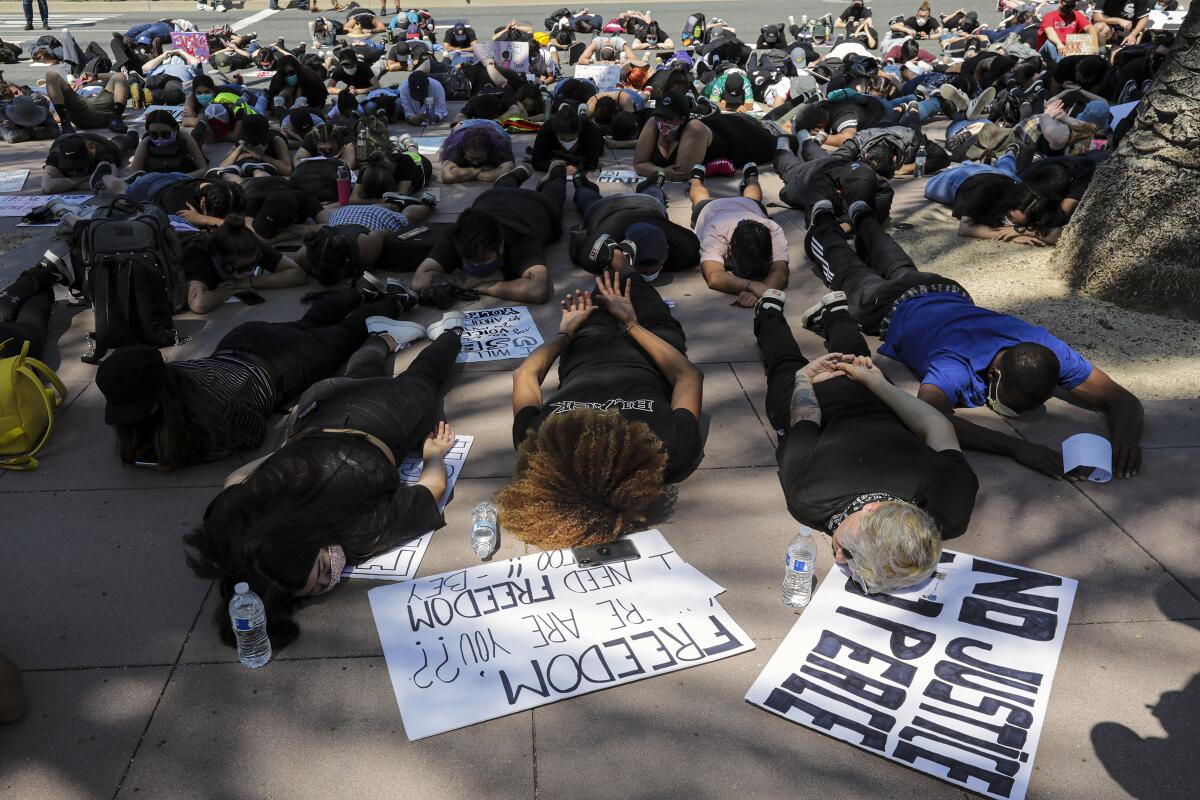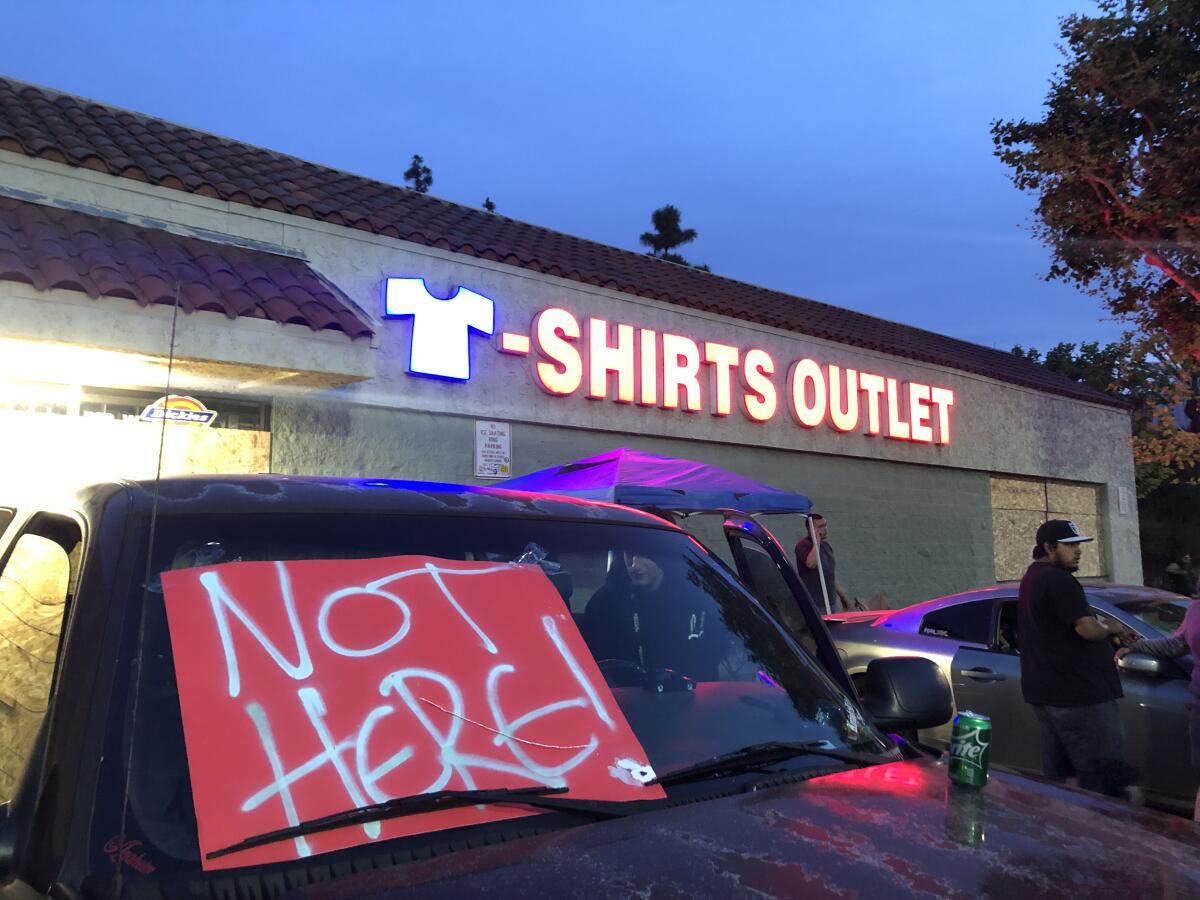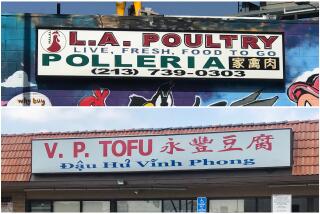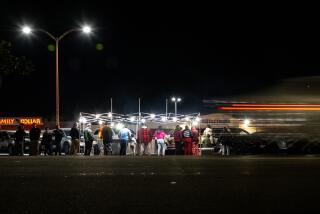They protected barrios against looting. ‘Don’t come here to tag up all these walls, homie’

Dressed in a black tank top and black shorts that stretched down to his shins, Orlando Fuentes stood in front of a boarded-up T-shirt store at the Anaheim Towne Center on Monday night. About 30 other people and a pit bull named Daisy were with him.
Everyone looked like they were ready to throw down.
Earlier that day, over 1,000 people had peacefully marched past the downtown shopping plaza to decry police brutality. Now, it was two hours past curfew.
Nearby, an Orange County Sheriff’s Department SWAT armored vehicle stuffed with deputies warned anyone within hearing distance to leave. Illegal fireworks crackled in the distance. Police raced around town to pursue stragglers; deputies guarded other businesses.
But Fuentes and his homies weren’t going anywhere.
“I’ve been coming to this store since I was a kid,” explained the 30-year-old. “And no way are we going to let outsiders mess with it. We’re going to stay here all night if we have to.”
He and his friends had blocked off the driveway near the store with well-kept sports cars and trucks with poster boards that declared “Keep it moving” and “Not here.” Westside Connection’s “Bow Down” rattled out from a Lexus. Vehicles tried to still get in, only to be told politely but firmly to turn around.
Moved by the death of George Floyd in Minneapolis, his neck pinned under the knee of a police officer, mostly peaceful protesters have gathered across cities in the U.S. day after day. But in their wake, looters have vandalized property and pillaged stores.
To those standing outside the T-shirt store, it didn’t matter whether they came from miles away or just around the corner.
“I’m tired of our own people doing damage to our own kind,” said 25-year-old Jesus Gallo. He had just moved to Garden Grove from Minneapolis, where family members were now out of work after rioting shut down their businesses. “This is what I’m here for. We gotta protect the ’hood.”
“Look at the big crowd here against a bunch of instigators,” said Cecilia Araceli Vasquez, 25. “All of us are wearing at least something from the shop. We don’t want this place burned down.”
T-Shirts Outlet owner Christine Sim and her daughter, Michelle, looked on with appreciation. In 2012, their store suffered thousands of dollars in damage after a protest in front of Anaheim City Hall against the shooting deaths of two Latinos by Anaheim police turned into a riot.
“We were losing sleep over what could’ve possibly happened tonight,” said 29-year-old Michelle. “But our customers helped us board up the store. And now they’re here. Just seeing everyone show up is so touching.”
It was a scene repeated in barrios across Southern California that saw anti-police-brutality protests wind through their working-class neighborhoods. Residents stood outside their homes and shops to support the message but also to offer one of their own: Don’t mess with us.
In Santa Ana, site of a rally of more than 2,000 people Sunday, grease-stained auto mechanics in work uniforms kept wrenches by their side as they looked on. During the Anaheim rally, a muscular, shirtless man with tattoos across his chest and abdomen ran out of a house to confront a car driver who kept peeling his tires. “Cut it out!” he shouted “All this smoke doesn’t do nothing!”
On Whittier Boulevard in East L.A. on Tuesday, video captured members of the Klique Car Club outside a Nike store waving signs that read “Not on the Blvd” and “Don’t Steal or Disrespect” the historic thoroughfare.
“This is what we’ve all fought out here for,” said Stephan Ruelas, as he stood near a vintage Chevrolet Fleetline lowrider and pointed to the iconic Whittier Boulevard sign. “We’re not going to let nobody come and destroy it.”
Ulisses Sanchez, who shot the footage, said he and other residents were proud of people like Ruelas. “We know it’s important for all of us,” said the small-business owner and Boyle Heights native, “to take ownership of our roles as caretakers of those who are a part of our community.”
Something similar is happening in the suburbs, from Huntington Beach and Newport Beach to Yucaipa — though often with a distinct tenor. There, residents have met Black Lives Matter activists with U.S. flags and jeers and racial epithets. In Upland, police arrested a man for threatening protesters with an AR-15 assault rifle.
But what’s happening in barrios is different, says Cal Poly Pomona urban planning professor Alvaro Huerta. There, complaints against police brutality go back decades. But longtimers don’t want outsiders to agitate on their behalf.
“When it’s suburban or right-wing people, it’s more of an exclusionary act of trying to keep the ‘other’ out,’ said Huerta, who grew up in the Ramona Gardens housing projects in L.A.’s Eastside. “For us, it’s like: ‘This is all we have, but we’re proud of it. Don’t mess with it.’”
He says the deep-rooted connection comes from the rural heritage of barrio residents.
“We’ve always identified with a place. It’s not just Zacatecas; it’s Jerez, Zacatecas. It’s not just Michcoacan; it’s Morelia. You see the same thing in Appalachia,” Huerta said. “Middle-class people can move around, so there’s not that same affiliation with place.”
Tales of protecting the barrio get told around local Mexican American circles like war stories. On Sanchez’s Facebook page, some remembered how members of Cal State Los Angeles’ MEChA student group stood vigil on Whittier Boulevard during the 1992 L.A. riots. Many Eastsiders still recount with pride how it was their neighborhood that caught Richard Ramirez, the infamous “Night Stalker,” when law enforcement couldn’t.

That espirit de corps was evident at the Anaheim Town Center on Monday.
Nearly everyone had the same story: Born and raised in the city. Like their parents. Attended Anaheim High. Mexican American.
“We’re proud of what’s here, and we need to take care of it,” said JR Leal, 26. He and others had just chased off two men trying to break into a T-Mobile store, and also put out a small brush fire set by a bandanna-clad white guy. Suddenly, a teenager tried to graffiti a Citibank branch.
Leal and others quickly swarmed the young Latino.
Anna Chavez, 19, dressed in red high-top Converse, shorts and a sweatshirt that said “Anaheim,” had just come from the march. She removed her black mask but maintained social distance before unloading on the wannabe tagger.
“This is our … city!” she yelled.
“We were born and raised here — come on, now!” added Jesse Martinez, 30.
“Don’t come here to tag up all these walls, homie,” said someone else, before letting loose a string of expletives.
The teen turned over his spray can and sulked off.
“Outsiders don’t care about what happens here,” Chavez said. “That tagger? He wasn’t even from here. He was from Santa Ana.”
“This is very inspiring today,” said Edgar Alvarez, 30, as he jogged off to the east. Rumor had it that anarchists were a couple of blocks away. “People call us thugs. But today, we see thugs protecting the city.”
More to Read
Sign up for Essential California
The most important California stories and recommendations in your inbox every morning.
You may occasionally receive promotional content from the Los Angeles Times.











